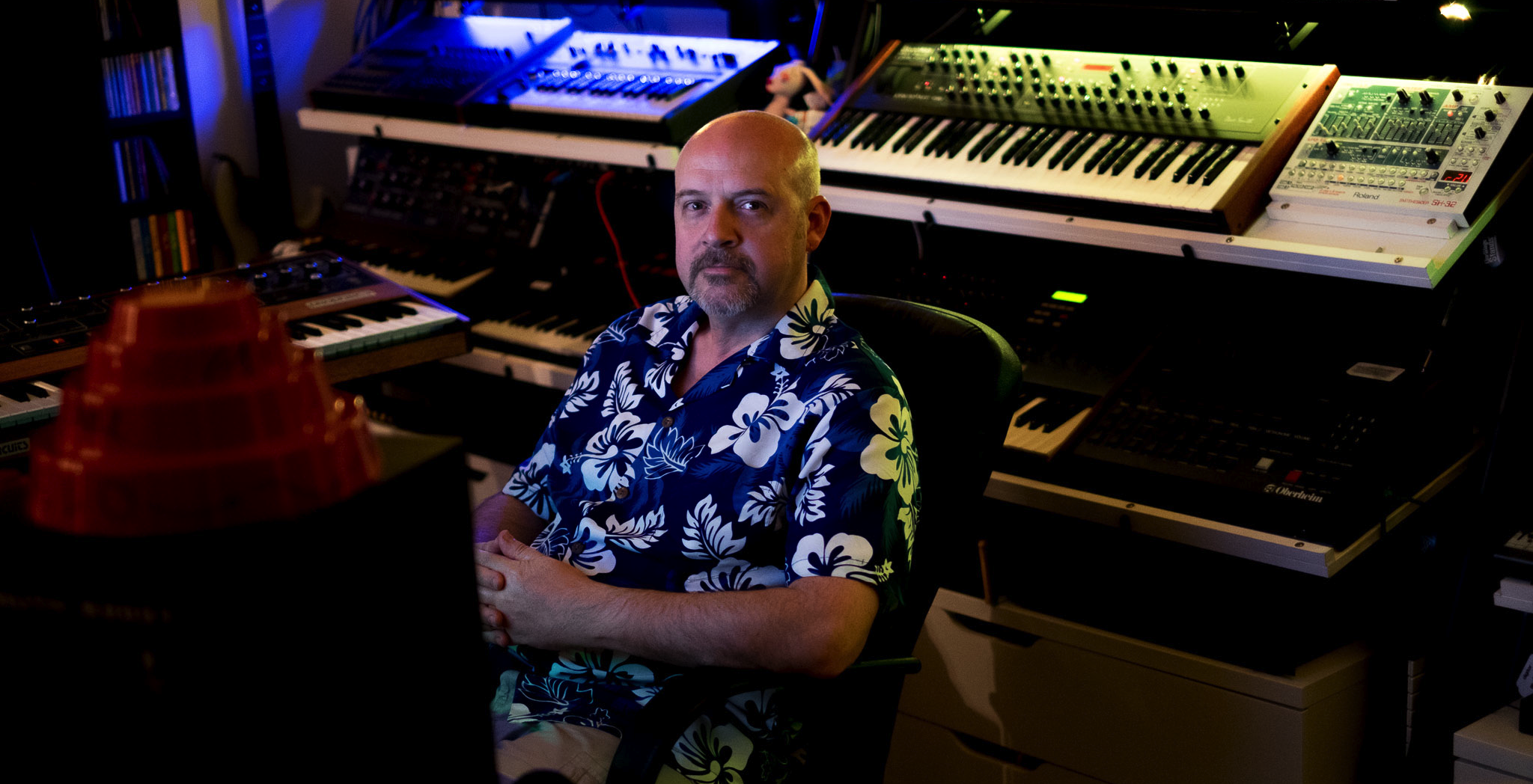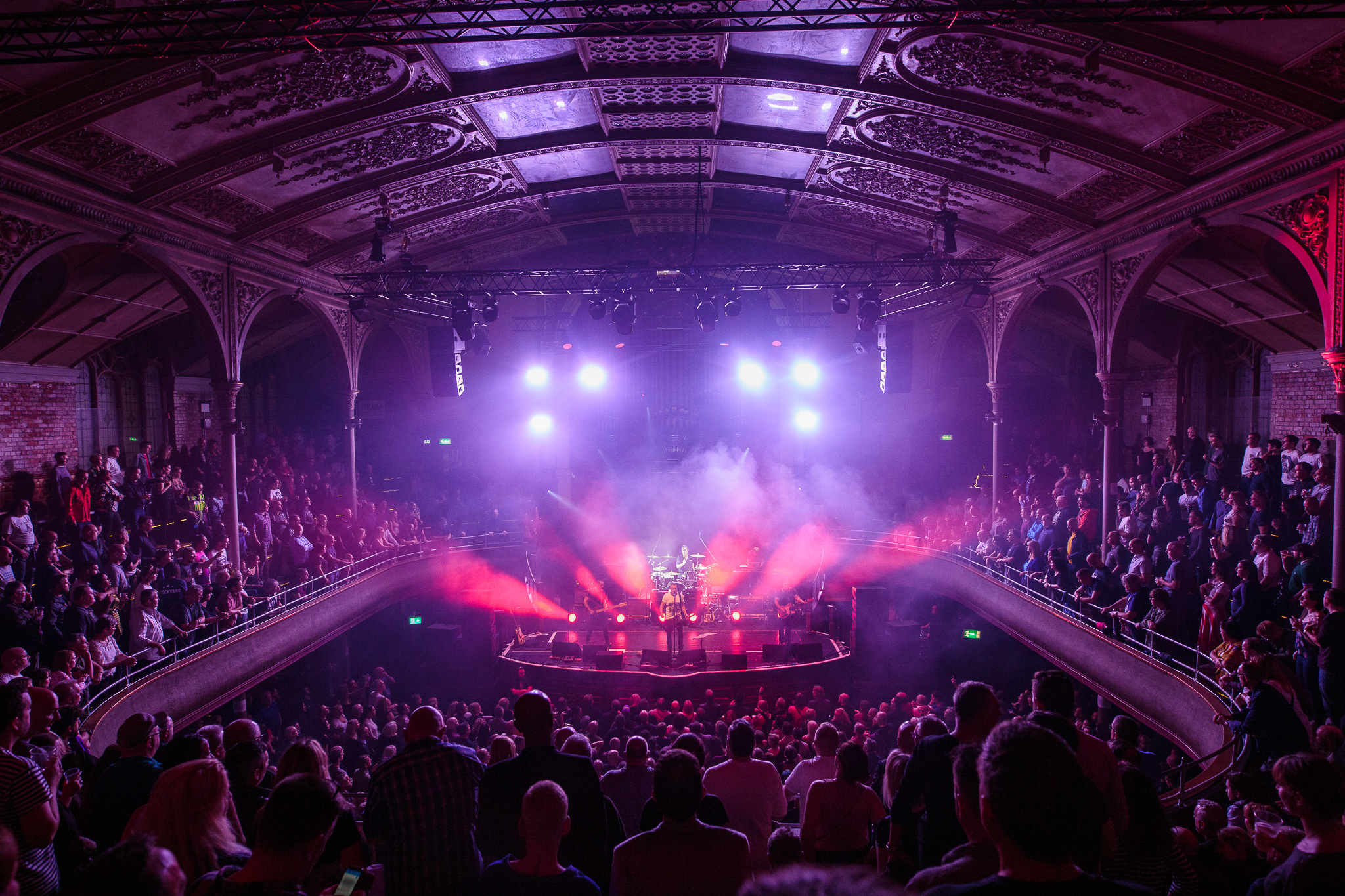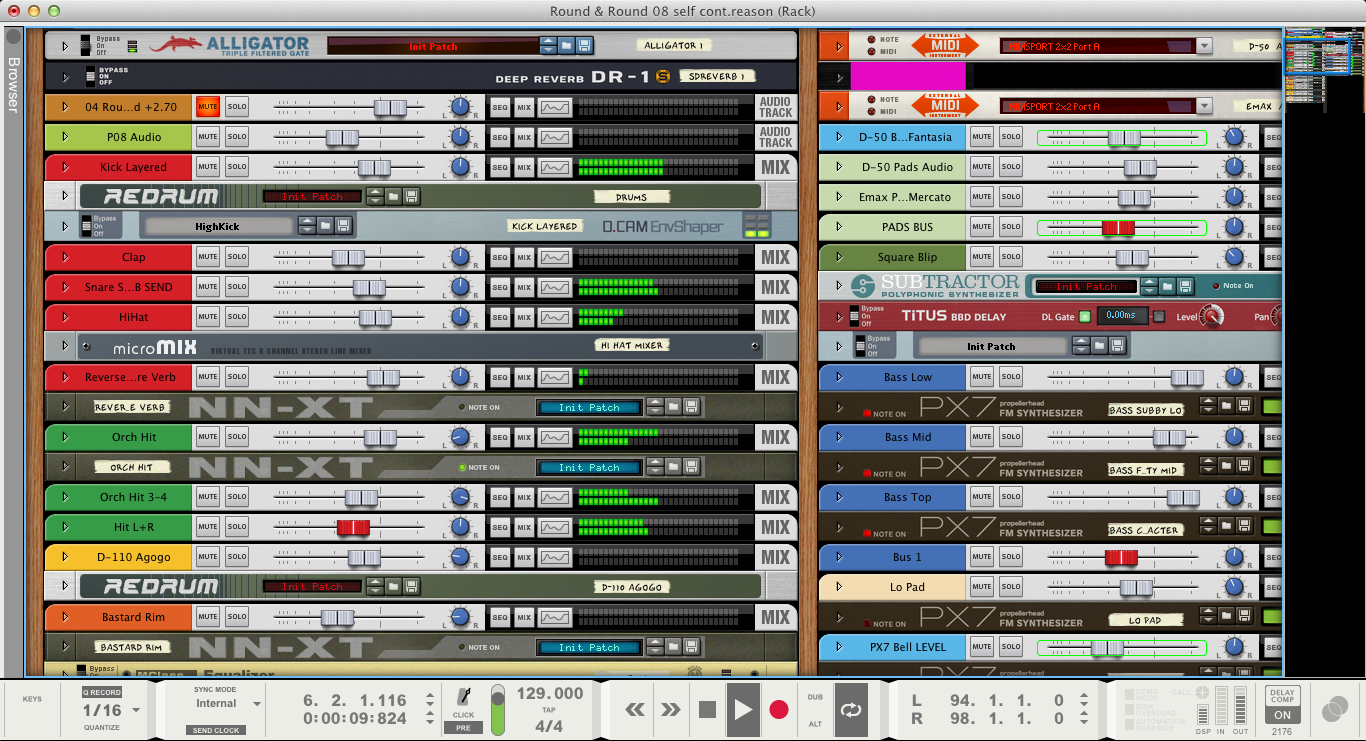 Ken Evans in the Tycho Central Studio
Ken Evans in the Tycho Central Studio
Ken Evans has been creating electronic music in the synth pop genre since 1985. In 1993 he co-founded the Brisbane (Australia) band Tycho Brahe, which has so far released five albums and a number of singles and EPs, has appeared on numerous compilations, and has remixed and produced other artists. Various live lineups of Tycho Brahe based around the core duo of Ken Evans and Georgina Emery have performed with or opened for acts such as The Human League, John Foxx, Real Life, Pseudo Echo, VNV Nation, Covenant and others. Ken established Tycho Sound Design as a separate business in 2017, to provide production services outside of the band framework.
The major project at that time was the construction of new live backing tracks for songs from the New Order albums “Technique” and “Republic” for ex-Joy Division/New Order bassist Peter Hook, for international touring as Peter Hook & The Light. This followed on from similar work for Peter Hook’s previous “Substance” tour. Ken creates brand new versions of all of the sequenced synth and drum machine parts of these classic recordings in Reason, using a combination of Reason instruments and Rack Extensions, VST’s, vintage hardware synths and drum machines, all sequenced, recorded and mixed in Reason.
“my job is to re-create all of those classic synth and drum machine sounds and sequences as accurately as possible”How did this project come about? Initially I was a fan of Peter Hook & The Light, but through contact with their keyboard player at the time (Andy Poole), he became aware of my production work for Tycho Brahe and other acts. Around 2015, Andy asked if I could create a new backing track for “Bizarre Love Triangle”. The band were impressed with the quality and accuracy of my work on that, so asked me to redo some of their other backing tracks. They were touring New Order’s “Low Life” and “Brotherhood” albums at the time, so I ended up creating new backing tracks for “The Perfect Kiss” and others, plus some other minor sound design work. By late 2016 they were touring North America on their “Substance” tour, and I was creating new backing tracks whilst they were on the road. I’d send over new tracks, and they’d substitute them in and sort them out at soundcheck for that night’s show. All up I created new backing tracks for around half of the New Order songs on the Substance tour, in addition to “Bizarre Love Triangle” and “The Perfect Kiss, this included “1963”, “Shellshock”, “Confusion (’87 version)”, “Subculture”, plus some additional sound design and production work on “Blue Monday” and “Hurt”.
Hooky subsequently asked me to do the same for the “Technique” and “Republic” albums, plus all of the associated singles and b-sides from that era. So for his gigs with The Light my job is to re-create all of those classic synth and drum machine sounds and sequences as accurately as possible from the ground up, with only the released versions as a guide. It is very challenging work!
 Peter Hook & The Light at The Albert Hall, Manchester
Peter Hook & The Light at The Albert Hall, Manchester
 The Reason project for “Round & Round” off of New Order’s “Technique” (1989)
The Reason project for “Round & Round” off of New Order’s “Technique” (1989)
Keeping all the parts separate enabled the band to further edit the arrangement if required, and to adjust the overall balance and mix for whichever live venue. Martin Rebelski (ex-Doves, current keyboardist with The Light) and Paul Kehoe (drums) could then also choose which parts to play live – these parts being muted or removed from the live playback files. For most of the keyboard parts played live, I supplied Martin with multi-samples of the required sound usually as an NN-XT patch, or sometimes as several NN-XT patches and/or synth patches arranged in a Combinator with keyboard splits and effects etc. The band uses Reason for live keyboards, which made it really simple to supply patches to them sourced from my Reason sessions. Paul was also supplied with many of the distinctive electronic drum and percussion sounds I’d created, exported directly from Reason with processing intact, so those parts could be muted or removed from the backing track files, loaded into his drum hardware and then played live via drum triggers or drum pads where required.
There was an immense focus on getting the electronic parts of these songs sounding as close to the originals as possible, including all of the tiny details with obsessively accurate sound design and sequencing. Some of the more complex songs took up to 60 hours from start to completion, and nothing was regarded as being completed until everyone involved was satisfied. Overall, I put in more than 1000 hours of work across 20 songs for the Technique/Republic project. Hooky’s response to the work was overwhelmingly positive – that it sounded as good as the original, and of course this was immensely validating and satisfying feedback for me. A few years ago I couldn’t have realistically contemplated a project of this complexity with this degree of sonic accuracy, but it was all completed via Reason in my small studio, Tycho Central. It is an incredible experience for me personally to see the band live, incorporating my backing track work for these classic songs with live drums, guitar, keyboards, vocals, and of course Hooky’s signature bass guitar sound, at a typically sold out gig. Which Reason instruments or Rack Extension play the biggest role in this project? Every session used multiple instances of NN-XT, ReDrum, Subtractor, and the PX7 Rack Extension in particular, but through the course of the entire project I probably used almost everything on hand at one point or another…it was whatever would get the job done best. The NN-XT sampler was often used to fly in stock Emulator II library samples that I’d converted to wav format, or in some cases I’d sample one of my hardware synths to manipulate the sample further. I love the NN-XT as its architecture is very similar to my old Ensoniq hardware samplers which I used through the ’90s and ’00s, but there’s a massive amount of flexibility and sample editing capability in NN-XT, plus the ability to drag and drop samples from the browser made auditioning samples very fast and simple. For a lot of the drum machine sounds including 808’s and 909’s I used samples loaded into ReDrum, or if it was an older analogue machine with some wobble to it I used multi-samples in NN-XT in “round robin” mode, with “alt” selected for the sample group, to get that subtle variation between hits. Propellerhead’s PX7 was used on many of the bass synth parts for this project… often I would layer two PX7’s each with different but complimenting bass sounds to fatten things up. For pads and strings often I’d layer a PX7 with my hardware D-50 or my hardware Emax sampler – I’d sequence the hardware synth from Reason using External MIDI Instrument, and record the hardware unit’s audio into Reason, and then route the software instrument and hardware synth’s recorded audio to a new output bus in the Reason Mixer for combined processing, EQ, effects etc to glue the layered sound together. Subtractor got a lot of use for the rapid monophonic sequences, and Thor got a lot of use too, for example the big sawtooth synth chord sound on “World (The Price of Love)” is all Thor, which I was then able to supply as a patch to Martin to play live. All of the mixing was done in the box in Reason, using the mixer’s EQ and channel compression… the RV7000 MkII Reverb, The Echo, and Scream 4 Distortion were all used a lot… Sometimes for a bit of colour I would run sounds through the BV512 Digital Vocoder, just using it as an EQ. The Alligator Filter Gate was also used a lot just for its filter section for a bit of colour, although the gating was used extensively on some songs like “Mr Disco”, where the entire mix is gated through it at one point. Reason’s MClass Equalizer, Compressor and Maximizer were used heavily, also Softube’s Saturation Knob to warm things up a bit, the Jiggery Pokery Chenille BBD Chorus Ensemble, FXpansion’s DCAM EnvShaper, Synapse DR-1 Deep Reverb, and many others… it’s a very long list. Reason’s External MIDI Instrument was crucial – this enabled me to very easily integrate various hardware units into a session, such as my Prophet 5, D-50, Juno-106, Emax sampler, etc and via a MIDI to CV/Gate converter my vintage Minimoog, SH-101 etc. The clock out let me sync various other units like my Oberheim DMX, Yamaha RX-5, LinnDrum, etc and my TB-303 which was clocked via a MIDI to DIN sync converter. The ability of Reason to be able to run VSTs as well really saved the day when it came to recreating parts of the Republic album, specifically via a VST version of the Korg M1. Overall, what made this project feasible for me was Reason’s ability to bring everything in the room together onto a single platform to get the job done – Reason instruments, Rack Extensions, MIDI sequencing, clocking, and recording of vintage hardware, plus VST’s, plus the ability to import or resample a mixture of audio file formats of differing sample rates etc for further processing in NN-XT and ReDrum, mixing it all “in the box” with full session recall, and then rendering the final files for live playback, plus exporting of live synth/sample patches and drum samples. What was the hardest part for you in recreating these classic tracks, and how did you overcome it? There were two major difficulties, the first being the very challenging reverse engineering of the original recordings. “Republic” in particular was sonically a very dense record, and it was an intense process trying to identify and work out all of the separate parts to re-create them. Some of the rapid complex sequences would require grabbing a section of the original, and time stretching it out or slowing it down to try to identify and map out what was actually going on, sometimes using EQ to help isolate a part for clearer listening, or other tricks like phase inverting a copy of the file against itself to reveal hidden details via phase cancellation…there were many, many hours of intense listening involved. Sometimes if something was really uncertain I’d consult with a band member for their opinion or discussion on a sound, a chord voicing, or some complex part. The second main difficulty was the sound design… often it was an educated guess as to which synth made which sound, and then you’d just try and build the sound using that synth or a representation of it, either from scratch or using a preset as a starting point. Some sounds were simple, or would be an obvious unaltered preset – for example the “Fantasia” patch from the Roland D-50 which is on several songs on “Technique”… but often you would dead-end with the sound design and have to go back to the drawing board and try a completely new and different approach; this sometimes got very frustrating. Some samples had to be re-created from scratch, for example there’s a sample of me in an NN-XT going “pah pah, pah-pah-pah!” on “Fine Time” to re-create Bernard Sumner’s vocal sample. I got my three sons in so we could re-create the “playing for England – En-Ger-Land!” football team vocal parts for “World In Motion” – all recorded in Reason with multiple passes using slightly different voices and accents for each pass to make 4 voices sound like 20. At times the complexity of the task seemed overwhelming or impossible, especially with the deadline of that first sold out gig looming…I had a little post-it note stuck to the bottom of my monitor on which I’d written, “You will always find a way through – eventually!”, but overall it just came down to some very intense listening, patience, some creative solutions and a very disciplined work ethic. Do you/Peter Hook also use Reason on stage playing these songs? The live keyboard parts for Peter Hook & The Light are played from Reason, either as multi-samples of various processed synths or Reason instruments, or as Reason synth patches or Combinators. Personally I’ve been using Reason live on stage with Tycho Brahe for many years, often at the centre of a 4 piece band – running playback sequences and sound files, supporting anything up to three controller keyboards, a full MIDI drum kit, and MIDI percussion pad all at the same time running from one computer with a multiple output audio interface. That rig replaced most of what we used to take out in the old days – multiple hardware samplers, digital playback machines, drum modules, etc – and we’ve used basically the same Reason-based live rig flawlessly for some major gigs, such as opening for The Human League in Sydney and Melbourne in 2009. I originally started using Reason way back in 2005 as a rationalised solution for our live shows – it still serves that purpose but these days it is also at the centre of all my recording and production work.For more info on Tycho Brahe and Tycho Sound Design: www.tycho.com.au www.facebook.com/tychobraheband
For more info on Peter Hook & The Light: www.peterhookandthelight.live www.facebook.com/peterhookandthelight



